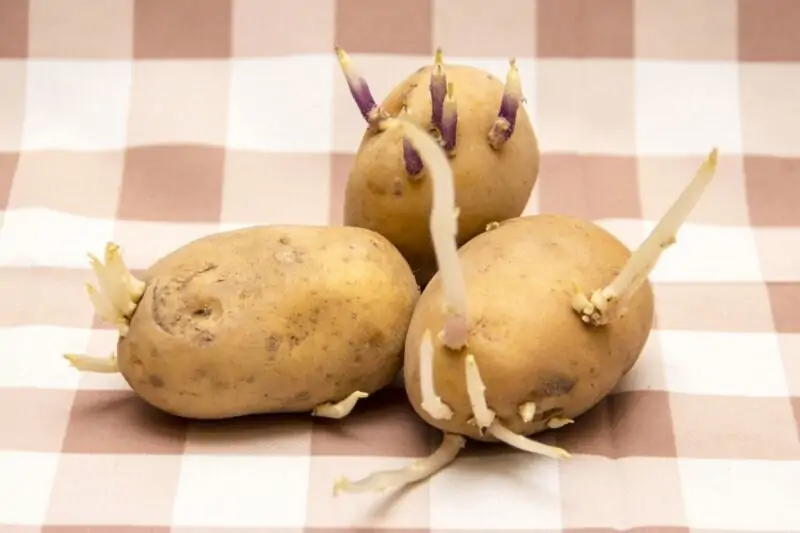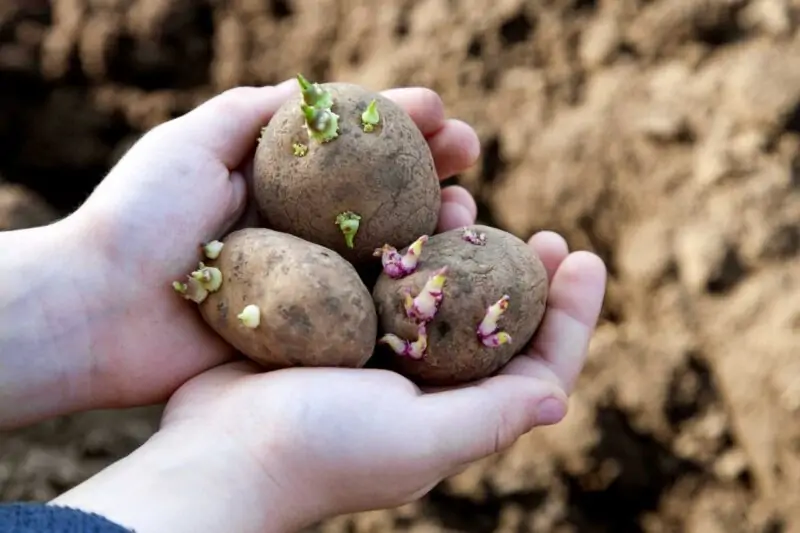Seed Potatoes for Planting: How to Get Potatoes to Sprout

Understanding the Basics of Potato Sprouting
Ah, potatoes! Who doesn’t love these versatile tubers? But, let’s face it, knowing how to get potatoes to sprout is a mystery for many of us. The process begins with a seed potato, which is just a potato with at least 2 eyes, or tiny sprouts. This means it hasn’t yet fully sprouted. When planted in the right conditions, this piece of potato grows quickly into a new potato. In other words, potatoes beget potatoes.
Before you can plant your potato, you need to learn the basics. The sprouting process, also called chitting is the potato’s natural reaction to the ideal temperature and light. It’s the first step in your gardening journey. Sprouting isn’t complicated, but understanding the basics is the foundation for successfully growing your own potatoes.
Benefits of Sprouting Your Own Potatoes
Sprouting your own potatoes is like magic! No hocus-pocus here, just mother nature at her finest. By sprouting potatoes at home, you can control when and how your potatoes grow. It allows you to plan when to harvest the potatoes as well as the number of potatoes per growing cycle. Plus, you’ll know exactly where your food comes from, which is pretty cool. In our opinion, potatoes harvested at home just taste better.
Different Potato Varieties for Sprouting
There’s more to potatoes than just your everyday russet potatoes. Your choices range from early, mid, to late season types, each with its own growth and sprouting timelines. Early potatoes are ready to be planted in the soil sooner than others and are usually harvested in early spring. Mid-season potatoes will sprout around the same time but take longer to harvest. Lastly, late-season potatoes take the longest to sprout but are well worth the wait.
The Art of Sprouting Potatoes
What Does It Mean to Sprout Potatoes?
Sprouting potatoes means coaxing a potato to grow sprouts, those little green shoots that eventually become potato plants. Now you may think, “I got use potatoes from the store, but these potatoes don’t sprout!” Well, they can, but usually, those potatoes have been treated to prevent sprouting.
Store Bought Potatoes Vs Seed Potatoes
While you can technically use store-bought potatoes, certified seed potatoes are usually the way to go. They’re disease-free and ready to sprout. They come in different varieties, and many gardeners swear by them. In comparison, store-bought potatoes may carry diseases and don’t always sprout as you’d like them to.
Choosing the Right Potato Varieties for Sprouting
Picking the right potato variety to sprout is like choosing the right tool for a job. It depends on the variety’s growing season and your climate. Whether you prefer russet, Yukon gold, or fingerlings, there’s a potato variety that’ll suit your garden.
Preparing Potatoes for Planting
Procuring Quality Seed Potatoes
Choosing quality seed potatoes is crucial. Look for certified seed potatoes from a reputable gardener. They should have multiple eyes and be free of blemishes or cuts. You’ll get the best results by starting with healthy seed potatoes.
Cutting Potatoes for Sprouting
Some gardeners cut the potato, putting them in the soil to sprout, but others plant them whole. If you decide to cut your potatoes, make sure each piece has at least one eye. Let the cut potatoes dry for a day or two before you put these potatoes in the ground.
Storing Potatoes Before Planting
Once you’ve procured your seed potatoes, store them in a cool, dark place until you’re ready to plant. Don’t worry if they begin to sprout; that’s what they’re supposed to do! Just ensure the fragile sprouts do not get damaged.
The Process of Chitting Potatoes
What Is Chitting?
Chitting is the process of pre-sprouting your potatoes before planting. This helps speed up the sprouting process, and it’s especially useful for late-season varieties or if you’re growing potatoes in an open space in colder climates. The goal is to get your potatoes to sprout 2-3 weeks before you actually plant them in the ground.
How to Chit Potatoes: A Step-by-Step Guide
The chitting process begins with placing your seed potatoes in an egg carton or a paper bag with the sprouts facing up. Then set the potatoes in indirect light at an ideal temperature, around 50°F (10°C). The eyes will begin to sprout after a couple of weeks. Don’t be scared if you see sprouts; it’s all part of the plan!
Speeding Up Potato Sprouting Through Chitting
To speed up potato sprouting, keep the chitting potatoes at a slightly higher temperature, around 60-70°F (15-21°C). However, make sure not to expose them to direct sunlight, which could cause potatoes to develop a green hue and become toxic.
How to Get Potatoes to Sprout
Suitable Conditions for Potato Sprouting
The conditions to sprout the potatoes are pretty straightforward. Potatoes need light, but not direct sunlight, and a cool temperature. So, think of a place like your basement or garage. Keep in mind that potatoes tend to sprout faster when they’re warmer, but don’t go overboard.
Watering Potatoes for Optimum Sprouting
Potatoes are a bit like Goldilocks; they need just the right amount of water. Too little, and they dry out. Too much, and they can rot. The soil should be moist but not waterlogged. They usually need about 1-2 inches of water per week.
Growing Sprouts: Caring for Your Sprouting Seed Potatoes
Caring for your sprouting potatoes is an exercise in patience. Watch out for signs of disease or pests, and remove any affected sprouts immediately. Rotate the potatoes once in a while to ensure even sprouting. Your sprouts are fully ready to grow new plants once they are about 1 inch long.
Planting Sprouted Potatoes

When to Plant Sprouted Potatoes
Timing is everything. You want to plant your sprouted potatoes as soon as the ground can be worked, typically a couple of weeks after the last frost date in your area.
How to Plant Potatoes: Techniques and Tips
Planting potatoes is easy as pie. Dig a hole about 4 inches deep, place the sprouted potato with sprouts facing up, then cover with soil. Keep the soil around the potatoes loose and well-drained for the best results. You can plant potatoes in raised beds or in containers, too.
Care After Planting: How to Water and Grow Potatoes
After planting, the potatoes need a growing medium that’s moist but not soggy. Water your potatoes once or twice a week, depending on how quickly the soil dries out. Watch out for pests and diseases like potato blight, and if your potatoes set flowers, that means tubers are forming!
Harvesting Your Sprouted Potatoes
Recognizing When Potatoes Are Ready for Harvest
You’ll know it’s harvest time when the plants start to yellow and die back, usually one to three months in the soil. For new potatoes, you can harvest them as soon as the flowers start to bloom. These young spuds are tender and delicious!
How to Harvest Potatoes Without Damaging Them
Harvesting potatoes is a bit like a treasure hunt. Use a garden fork to gently dig around the plant, taking care not to stab any hidden treasures. Start from the outside and work your way in, lifting the potatoes from the soil. You’ll feel like a kid in a candy store, trust me!
Storing Your Harvested Potatoes
Once harvested, store potatoes in a cool, dark place. They need good air circulation, so keep them in an open bag or box. Brush off any soil but resist the temptation to wash them until you’re ready to use them. Stored properly, your potatoes can last several months.
FAQs
Sure, you can plant any potato that sprouts, but seed potatoes are your best bet for a healthy potato crop. They’re bred for growing and are disease-free, giving you a head start in your garden.
Patience, my friend, patience. Potatoes can take 2-4 weeks to sprout, depending on the variety and conditions. Remember, great things take time!
When the sprouts are about 1 inch long, they’re ready for planting. If your potatoes haven’t sprouted enough in time, don’t fret. They’ll catch up in the ground.
Sprouted potatoes are safe to eat as long as the potato is still firm and the sprouts are small. But, if the potato is soft or shriveled, or the sprouts are large and green, it’s best to toss it.
Store potatoes in a cool, dark, well-ventilated place to slow down sprouting. If you notice sprouts, just break them off before cooking.
Conclusion
So, there you have it! A complete guide on how to get potatoes to sprout. From understanding the sprouting process, selecting the right seed potatoes, chitting, and caring for your sprouting spuds, all the way to planting, growing, and harvesting your potatoes. You’re now armed with all the knowledge you need to successfully grow potatoes in your garden. So, what are you waiting for? Get your hands dirty and let the potato growing season begin!